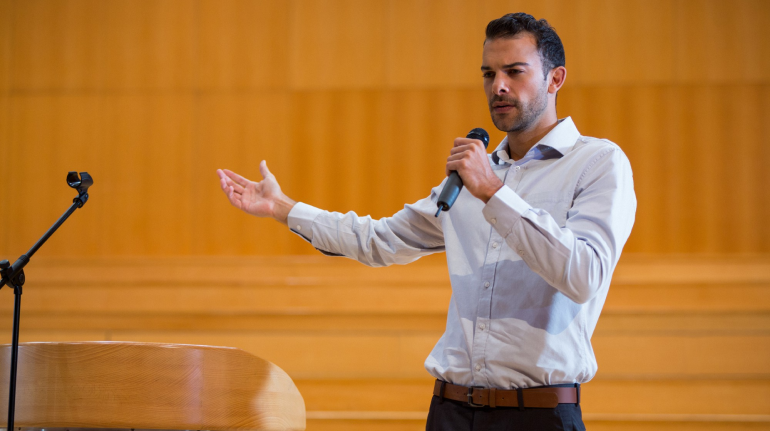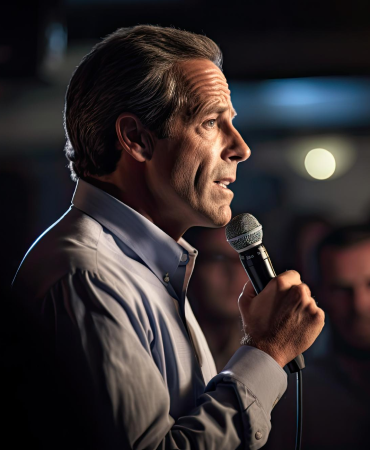Motivational speaking can be a powerful tool in the arsenal of communication, when your aim is to inspire, influence, and advocate for change. Motivational speaking is not just about evoking emotions but encompasses a strategic blend of storytelling, persuasion, and audience engagement, all aimed at promoting a shift in thinking.
It encourages listeners to consider thinking differently about their aspirations or view their challenges from a refreshed perspective.
The close relationship between motivational speaking and traditional public speaking is worth looking at closely. Suasive, a company renowned for its excellence in public speaking training, offers a distinctive viewpoint on the relationship. While there are similarities in structure and the need for clarity and engagement, motivational speaking and public speaking differ fundamentally in their objectives and approaches. Motivational speaking seeks to inspire and energize, whereas public speaking, as taught by Suasive, focuses more on delivering clear, concise communication designed to drive specific actions or decisions. The differences are subtle, but when applied, understanding the Suasive approach to public speaking will give any motivational speaker a considerable advantage for their next motivational speaking engagement.
In this article, we’ll examine how integrating public speaking techniques, as advocated by leading communication experts, can significantly enhance the effectiveness of motivational speeches. We’ll uncover how these two forms of communication intertwine, revealing that mastering both is key to creating truly powerful and impactful speeches.
Why Do People Give Motivational Speeches?
What is the Difference Between Motivational Speaking and Public Speaking?
Why are Motivational Speakers Important?
What Makes a Motivational Speaker Good?
The Best Motivational Speeches of All Time
What is the Meaning of Motivational Speaking?

Motivational speaking, at its core, is about inspiring and energizing an audience, often leading to personal or professional growth. It involves crafting and delivering messages that resonate deeply with listeners, aiming to motivate them towards achieving goals, overcoming challenges, or changing their perspectives. The primary objective of motivational speaking is to create an emotional connection, stirring the audience’s aspirations, and motivating action or change.
However, to draw a clear distinction, motivational speaking differs from public speaking in several key aspects. While public speaking encompasses a wide range of communication styles and objectives – from informative and persuasive to ceremonial – motivational speaking is specifically tailored to inspire and energize. Public speaking often focuses on the clear, effective transmission of information or arguments. It requires skills in organizing content, delivering it confidently, and engaging the audience logically and coherently.
In contrast, motivational speaking is more often thought of in terms of personal anecdotes and emotional appeals. It relies more on the speaker’s ability to connect with the audience on a personal level, using narrative techniques to evoke feelings and inspire action. Motivational speakers often share their experiences, challenges, and triumphs in a way that resonates with the audience’s desires and struggles.
Understanding the principles of public speaking is crucial for anyone aspiring to excel in motivational speaking. Mastery of public speaking skills – such as a clear message, effectively structuring content, audience engagement, and confident delivery – can significantly enhance the impact of motivational speeches. These fundamental skills ensure that the inspirational message is not only heard but also understood and remembered. They provide a framework within which the motivational message can be effectively conveyed.
BE AN EFFECTIVE COMMUNICATORSuasive Presentation Coaching
Our ProgramsWhy Do People Give Motivational Speeches?

Motivational speeches stem from a desire to influence positive change. Whether it’s to inspire a group, ignite a movement, or encourage personal and professional growth, motivational speakers share a common goal: to make a meaningful impact on their audience. The reasons behind giving motivational speeches are as varied as the speakers themselves, but they all center around the power of words to motivate and inspire.
One primary reason for delivering motivational speeches is to share personal experiences and insights that can guide and inspire others. Many motivational speakers have overcome significant challenges or achieved notable successes, and they use their stories as a tool to encourage others. These narratives often serve as a source of inspiration, offering tangible proof that obstacles can be overcome and goals can be achieved.
Another reason is to impart wisdom and lessons learned. Motivational speeches often provide guidance, offering strategies and tips for personal development, career advancement, or overcoming life’s hurdles.
Motivational speaking can be a powerful tool for fostering a sense of community and shared purpose. By addressing common challenges and aspirations, speakers can unite their audience around a common goal or cause, building solidarity and a collective sense of determination.
The Suasive methodology suggests there’s a strong emphasis on the impact of motivational speaking beyond just emotional engagement. It’s about crafting a narrative that not only inspires but also propels the audience towards specific actions or outcomes. This perspective aligns with the concept that effective motivational speaking is a blend of emotional connection and clear, engaging delivery.
What is the Difference Between Motivational Speaking and Public Speaking?

Understanding the nuances between motivational speaking and public speaking is key to mastering the art of impactful communication. While both forms share the common goal of engaging and addressing an audience, the approach, content, and desired outcomes significantly differ.
Motivational speaking is inherently designed to inspire and energize an audience. It often involves sharing personal stories, experiences, and insights that resonate on an emotional level, aiming to provoke thought and inspire change. The success of motivational speaking hinges on the speaker’s ability to connect with the audience’s emotions and aspirations, encouraging them to overcome obstacles or pursue their goals with renewed vigor.
On the other hand, public speaking, as taught by organizations like Suasive, places a strong emphasis on structure, organization, and the clear delivery of content. This form of communication is often more informational or persuasive in nature, focusing on presenting facts, arguments, and ideas in a coherent and logical manner. Public speaking skills include the ability to create a well-structured narrative, maintain audience engagement through effective delivery techniques, and convey messages with clarity and precision.
The differences highlighted here are crucial in understanding how elements of public speaking can benefit motivational speakers. A well-organized speech with a clear structure helps in delivering a more coherent and impactful message. By incorporating these elements, motivational speakers can enhance their ability to guide the audience through their narrative seamlessly, ensuring that the key messages are not lost in the emotional aspects of the speech.
Additionally, the techniques of audience engagement and clarity in message delivery, central to public speaking, are equally important in motivational speaking. These skills ensure that the motivational message is not only emotionally resonant but also easily understandable and memorable. By marrying the emotive power of motivational speaking with the structured approach of public speaking, speakers can create speeches that are not only inspiring but also clear and impactful.
Why are Motivational Speakers Important?

Motivational speakers play a crucial role across various sectors, from corporate environments to educational institutions, and even in personal development settings. Their importance lies in their ability to inspire change, provoke thought, and catalyze action among their audiences. Through their speeches, motivational speakers can influence a wide range of outcomes, from boosting morale and productivity to fostering personal growth and development.
In the corporate world, motivational speakers are often brought in to invigorate teams, especially during times of significant change or challenge. For example, a company undergoing a major restructuring might invite a motivational speaker to address the workforce. Through their speech, the speaker can instill a sense of purpose and direction, helping employees navigate through the uncertainty and view the change as an opportunity for growth and innovation.
In educational settings, motivational speakers can have a profound impact on students. By sharing stories of perseverance and success, they can inspire students to pursue their goals with determination. Consider a speaker who talks about overcoming personal obstacles to achieve academic success. This message can resonate deeply with students facing their own challenges, motivating them to persist and strive for excellence despite difficulties.
Motivational speakers are instrumental in personal development seminars and workshops. They often address topics related to self-improvement, goal setting, and overcoming personal barriers. For instance, a speaker who shares their journey of transforming from a timid individual to a confident public speaker can inspire others to embark on their journeys of self-improvement.
How to tell your story so the audience feels it’s their story.
Our MethodologyWhat Makes a Motivational Speaker Good?
A good motivational speaker possesses a unique blend of qualities that not only captivate the audience but also drive them to consider meaningful change. Integrating the public speaking approach advocated by Suasive, these qualities ensure that the speaker’s message is not only inspiring but also clear and impactful.
Ability to Connect Emotionally
A key quality of a motivational speaker is the ability to create an emotional connection with the audience. This involves understanding the audience’s needs and emotions and tailoring the message to resonate with them on a personal level. This is the essence of the Suasive approach to create Audience Advocacy® so the audience feels you see through their eyes and understand their perspective.
Clarity and Coherence
Drawing from Suasive’s approach to public speaking, clarity in conveying the message is paramount. A good motivational speaker articulates their thoughts in a manner that is easily understandable, avoiding ambiguity and ensuring that the core message is conveyed succinctly.
Effective Storytelling
Storytelling is a powerful tool in motivational speaking. A compelling narrative can engage the audience, making the message more relatable and memorable. Good motivational speakers use stories to illustrate their points and bring their messages to life.
Incorporating ‘WIIFY®’ (What’s In It For You)
This Suasive concept is about shifting the focus from the speaker to the audience. It involves framing the message in a way that highlights the benefits and takeaways for the audience, making the speech more audience-centric and impactful.
Strong Presence and Confidence
Confidence is contagious, and a motivational speaker with a strong presence can instill confidence in their audience. This involves not just what they say, but how they say it – their body language, tone of voice, and overall demeanor.
Audience Engagement
Engaging the audience is crucial. In addition to creating Audience Advocacy®, this can be achieved through interactive elements, questions, or relatable anecdotes. An engaged audience is more likely to absorb and act on the message.
Passion and Authenticity
Passion is infectious, and an authentic speaker can inspire an audience through their genuine enthusiasm and belief in their message. Authenticity builds trust and credibility, making the message more persuasive.
Call to Action
A great motivational speech often concludes with inspiring action. It directs the audience on what to do next, turning inspiration into tangible action.
A good motivational speech combines emotional intelligence with clear, structured communication, effective storytelling, audience engagement, and a focus on the audience’s benefits. These qualities, underpinned by the principles of effective public speaking, create speeches that not only inspire but also help the audience consider positive action and change.
The Best Motivational Speeches of All Time

Several motivational speeches have stood the test of time, resonating deeply with diverse audiences and leaving a lasting impact. These iconic speeches not only exemplify the power of motivational speaking but also align with the principles of effective public speaking, such as those advocated by Suasive.
Martin Luther King Jr.’s “I Have a Dream”
Martin Luther King Jr.’s “I Have a Dream” speech is perhaps one of the most renowned motivational speeches in history. Delivered during the March on Washington for Jobs and Freedom in 1963, King’s speech is a masterful display of emotional connection and powerful storytelling. He articulated a vision of equality and justice in a way that was both moving and inspiring. The speech’s structure was impeccable, with a clear beginning, middle, and an uplifting end, aligning with the principles of organized content delivery. King’s use of repetition and metaphor made the speech not only memorable but also deeply impactful, driving a nation towards significant social change.
Winston Churchill’s “We Shall Fight on the Beaches”
Delivered in 1940, Winston Churchill’s speech to the House of Commons of the United Kingdom was a rallying cry during a time of immense crisis. Churchill’s use of assertive and descriptive language demonstrated a powerful command of public speaking. His speech was structured to build momentum, moving from a sobering assessment of the present situation to a defiant declaration of resilience and determination. This speech perfectly encapsulates the concept of ‘WIIFY®’ – focusing on what the audience, in this case, the British people, stood to gain from their collective perseverance.
Steve Jobs’ 2005 Stanford Commencement Address
Steve Jobs’ commencement speech at Stanford University is a brilliant example of using personal stories to motivate and inspire. Jobs shared three personal stories from his life, each with a clear message and moral. He emphasized the importance of pursuing one’s passions and seeing opportunities in life’s setbacks. The speech’s structure was clear and concise, with each story contributing to the overall message about the unpredictability of life and the importance of resilience. Jobs’ ability to incorporate his own personal DNA in a conversational style made the speech relatable and engaging, a key aspect of effective motivational speaking.
J.K. Rowling’s Harvard Commencement Speech
In her speech at Harvard University, J.K. Rowling focused on the benefits of failure and the importance of imagination. Her speech was structured with a clear narrative, weaving her personal experiences with broader themes. Rowling’s speech demonstrated the power of vulnerability and authenticity in creating an emotional connection with the audience. She skillfully balanced humor with profound insights, engaging the audience while imparting valuable life lessons.
Malala Yousafzai’s Speech to the United Nations
Malala Yousafzai’s address to the United Nations on her 16th birthday in 2013 was a powerful advocacy for education rights. Despite her young age, Malala spoke with a clarity and conviction that resonated worldwide. Her speech was a testament to the power of a single voice to inspire global action. She used her personal story of survival and defiance to advocate for the rights of all children to education, effectively using the platform to drive a specific action – the call for universal access to education.
Each of these speeches demonstrates the elements that make motivational speaking effective. They show the power of a well-structured narrative, the importance of connecting with the audience on an emotional level, and the ability to articulate a clear message. These speakers effectively employed storytelling, emotional appeals, and a strong, confident presence to engage their audiences. Moreover, each speech had a specific purpose, whether it was to inspire action, instill hope, or advocate for change.
These iconic speeches also align with the public speaking principles as taught by Suasive. For instance, the concepts of Audience Advocacy® of WIIFY®’ (What’s In It For You) is evident in how these speakers made their messages relevant to their audiences. They focused on the benefits and takeaways for the audience, making their speeches more impactful and persuasive. This audience-centric approach is a key aspect of effective motivational speaking.
Another notable element is the use of clear and structured content delivery. These speeches were carefully crafted with a defined beginning, middle, and end, ensuring that the audience could easily follow and absorb the message. This structure helped to maintain audience engagement and made the speeches more memorable.
The ability to engage the audience is a hallmark of both motivational and public speaking. These iconic speeches were not passive monologues but dynamic interactions with the audience. The speakers used rhetorical devices, such as repetition, questions, and pauses, to involve the audience and emphasize key points.
Lastly, and most importantly, the authenticity of the speakers played a significant role in the effectiveness of these speeches. Authenticity builds trust and credibility, making the message more persuasive. Each speaker brought their unique personality and experiences to their speeches, which helped to establish a genuine connection with the audience.
COMMUNICATION
WITH PURPOSE
Famous Short Speeches With Inspirational Takeaways

John F. Kennedy’s Inaugural Address (1961)
John F. Kennedy’s inaugural address, particularly the famous line “Ask not what your country can do for you – ask what you can do for your country,” is an exemplary example of motivational speaking. Lasting just under 14 minutes, JFK’s speech effectively utilized rhetorical devices like antithesis and parallelism, aligning with public speaking techniques that emphasize clarity and impact. His speech was not just a call to action but an invitation for collective responsibility and national pride.
Lou Gehrig’s Farewell to Baseball (1939)
Lou Gehrig’s poignant farewell speech at Yankee Stadium is remembered for its humility and grace under adversity. Lasting just two minutes, Gehrig’s words, “Today, I consider myself the luckiest man on the face of the Earth,” resonate with courage and gratitude. This speech is a masterclass in emotional resonance, connecting deeply with the audience through personal vulnerability.
Mother Teresa’s Nobel Peace Prize Acceptance Speech (1979)
Mother Teresa’s Nobel Peace Prize acceptance speech, spanning just over 18 minutes, is an unforgettable reflection on compassion and service to humanity. Her simple yet powerful message about the importance of loving and caring for each other aligns with the public speaking principle of delivering a clear, heartfelt message that resonates on a human level.
The Gettysburg Address by Abraham Lincoln (1863)
Perhaps one of the most famous examples of brevity in speech making, Lincoln’s Gettysburg Address was just over two minutes long. It demonstrated the power of concise yet powerful messaging. Lincoln’s address, with its famous beginning “Four score and seven years ago,” utilized repetition and emotional appeal to convey a message of unity and dedication to the principles of liberty and equality.
Each of these speeches, despite their brevity, encapsulates elements of effective public speaking. They are structured for clarity, make powerful use of language, and connect with the audience on an emotional level. These speeches show that a clear, concise message, delivered authentically and with emotional intelligence, can be just as impactful, if not more so, than a longer discourse. They remain enduring examples of how short speeches can inspire, motivate, and leave a lasting impact on their audiences.
Conclusion

Throughout this article, we’ve unraveled the dynamic world of motivational speech, revealing its core elements and the impact it can have across various sectors. We’ve looked at the best motivational speakers in history and dissected what made their speeches so compelling and transformative. These icons of motivational speaking have set benchmarks for delivering a motivational talk that resonates deeply and helps elicits change.
We’ve also seen how the principles of public speaking, as championed by renowned organizations like Suasive, are integral to crafting a motivational speech that is not only emotionally stirring but also clear and impactful. These principles are the bedrock upon which a successful motivational speaking career can be built. They equip speakers with the necessary tools to engage and inspire their audience effectively.
For anyone aspiring to join the ranks of the best motivational speakers or to enhance their motivational speaking career, and get more motivational speaking opportunities, understanding and applying these foundational principles of public speaking is essential. Joining public speaking groups is one way to refine your skills, or even better get training from the best public speaking professionals in the world.
Executive Presence Training
Suasive, Inc. is a Silicon Valley-based communication consulting company that offers public speaking classes for organizations and individuals.
To date, we’ve coached over 600 IPOs and helped individuals in some of the world’s largest companies including Netflix, eBay, Sonos, Lyft, and Freshworks.